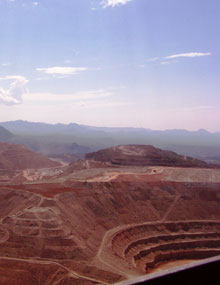Copper's Bright Past and Brighter Future
Here today, gone tomorrow; a truism in most cases, but not where copper is concerned. Copper is one of the most used and reused metals on earth. The copper used in your plumbing or cookware could have first been used hundreds, or even thousands of years ago.
According to the U.S. Bureau of Mines and the U.S. Geological Survey, known copper resources are estimated at nearly 5.8 trillion pounds worldwide, only about 0.7 trillion pounds of which have been mined to date. The recycling rate of copper is so high that nearly all of the copper mined throughout history - some estimates go as high as 80 percent - is still in circulation today. Every year in the US, nearly as much copper is recovered from recycled material as is mined. This is why the value of copper scrap remains so high, with premium-grade scrap maintaining at least 95 percent of the value of newly mined copper.
 A copper mine in Arizona, owned by Freeport McMoRan Copper & Gold Inc.
A copper mine in Arizona, owned by Freeport McMoRan Copper & Gold Inc. High-resolution version of this photo.
Copper use has withstood the test of time. Pure copper was the first metal used by man, and copper artifacts, like a copper pendant that was discovered in what is now northern Iraq, date back to about 8700 B.C.
The Egyptians took full advantage of mankind's first metal. Copper saws, chisels, knives, hoes, dishes and trays made thousands of years ago by Egyptian coppersmiths have been uncovered from tombs in excellent condition, showing surprising durability and longevity.
Today, copper, and its alloys brass and bronze, are used for faucets, locksets, door hardware, roofing, flashing, plumbing and electrical applications, as well as decorative products inside the home - the same unique characteristics that were admired centuries ago are still valued today.
Concerns about copper resources being in jeopardy are unfounded and probably based on speculation. While there has been tremendous fluctuation in copper production over the last few years, there is no indication that resources are tapering.
"Production relies on several factors, but mostly, it's the general state of the industry, projected prices and supply-and-demand balances," said Daniel Edelstein, who is a copper commodity specialist for the National Minerals Information Center. "We were in an upward swing when the recession hit. Since then, copper prices have recovered, but cutbacks in mining production that took place in 2009 have not been restored."
"In the US, there is at least one major mine working toward final approval in Arizona, which will produce about 100,000 pounds of copper per year, and we also have mines that are operating at less-than-capacity that will be restored," he added.
Edelstein said there is also a proposed mine in Alaska that can lead to the production of hundreds of thousands of pounds of copper annually, if environmental impact statements can be satisfied.
For those who were ever worried about copper production being in danger of coming to a halt, they can rest assured that it won't happen. Aside from using recycled and mined copper in US industries, there is also a tremendous amount of scrap metal that is exported.
"One of copper's many attributes is its recyclability," said CDA Vice President Bob Weed. "It is also an extremely durable metal, and when you use copper for a project, you can be certain that it will last a lifetime."
So, in addition to its inherent qualities of beauty, durability and low maintenance, copper is one of the most resource-efficient building materials available today, and it will continue to be readily available in the near and distant future.
For more information about copper, visit www.copper.org. Cu
